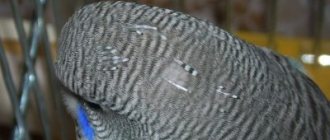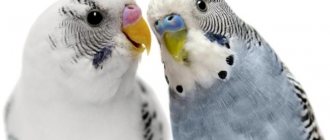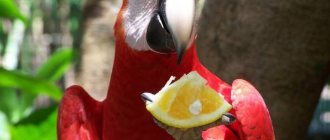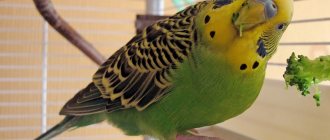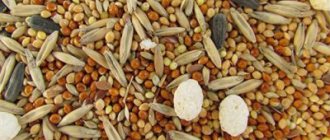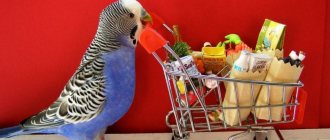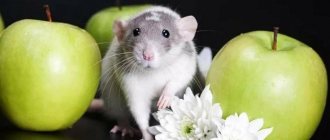Most owners of feathered pets offer their pets grain food as the main diet. However, this is not enough to provide the body with the necessary amount of nutrients. In nature, dry grain feed is not the basis of the bird’s diet. According to ornithologists, fruits for parrots are a mandatory component in the daily menu.
Here you will find the answer to the question: what fruits can budgies, cockatiels, lovebirds, grays, cockatoos, and Amazons eat? And also the answer to the second equally important question, which many often forget about - which ones are not allowed.
What can a bird do?
Birds will be happy with both dried and fresh fruits. Treats help you better build a strong relationship with your pet and make him sweet and obedient.
Birds will rarely agree to cut up a delicacy on their own, so it is better to prepare each fruit in advance for the bird to eat: grate, cut, turn into pulp. The parrot himself will tell you which preparation is best to make.
If we add to this a huge supply of all spectrums of vitamins in fruits, then we get a healthy, nutritious and pleasant product that improves the mood of both the bird and the owner.
Here is a list of healthy fruits that wavy eaters eat:
apples are a mild mixture of vitamins that will help your parrot better digest the main dish. Contains beneficial plant fibers and organic acids;- orange – contains difficult-to-digest fiber, essential essential oils and carbohydrates. This mixture of substances provides lasting protection against viruses and infections;
- Bananas are a storehouse of calcium, magnesium and potassium. It is highly nutritious, so it is perfect for a quick snack;
- grapes – contains the entire spectrum of microelements and B vitamins. Suitable as a delicacy for heavy food, because helps cleanse the body and remove all accumulated toxins;
- pomegranate – ensures stable functioning of the cardiovascular system of birds;
- apricot - large amounts of sugar, insulin and starch will make the budgie a little happier, and provitamin A, iron and acids strengthen the immune system and reduce the risks of cardiovascular diseases;
- kiwi – ranks first in terms of vitamin C content in fruits. It will make the parrot's feathers soft, pleasant and beautiful, and also protect against viruses;
- pineapple – works on muscles and blood vessels. Strengthens the health of the bird and helps to digest and assimilate food rich in protein;
- pears - ornithologists strongly recommend adding a piece of pear to every diet, because it contains a large amount of pectin, which effectively stimulates digestion. In addition, pears contain carbohydrates, iron and phosphorus.
- watermelon and melon - small amounts are allowed, but only those that you have already tried yourself.
All fruits must be thoroughly washed and peeled so that the budgie does not accidentally choke on the skin. It is also necessary to monitor the presence of seeds, because they contain hydrocyanic acid, which is dangerous for the stomach of birds.
It is also useful to read: How many times a day should you feed a budgie?
What to feed your budgie besides food
In addition to grain, succulent and green food, the parrot needs mineral nutrition and food of animal origin, rich in protein. Protein food is especially necessary during the period of molting and nesting of parrots. Parrots constantly need calcium, especially young ones. It is required for the construction and formation of the skeleton and the growth of plumage.
Mineral mixtures
In addition to grain and succulent food, the parrot needs calcium to strengthen bone tissue. You can buy chalk figurines, bone meal, or use grated eggshells as an additive. Chalk figures are also useful because the bird will sharpen its beak. There are also ready-made additional mixtures rich in minerals and calcium that can be added to your parrot's feeder.
What's prohibited
The curiosity of budgerigars sometimes backfires on their owners, so you need to keep an eye on what the pet pecks.
Ornithologists categorically prohibit feeding parrots from the common table, because... Human food is very poorly tolerated by birds and can cause irreparable damage.
Do you give your parrot fruit?
Yes No
The following are contraindicated for a feathered pet:
- papaya;
- mango;
- pomelo;
- persimmon;
- avocado.
These fruits are picked while still unripe, and they reach their ripeness only in the carrier’s car. In addition, their juice is rich in glycosides, papin and various alkaloids, which are poison for parrots.
Birds are not against dried fruits, but they can only be given after preliminary soaking . At the same time, all types of candied delicacies are contraindicated, but you can offer the bird dried fruits (raisins, prunes, dried apricots) pre-steamed with boiling water.
The value of a pear
It has unique health components in such a variety that many fruits can only dream of. It is dietary and indispensable for those who suffer from excess weight, diabetes, and disorders of the pancreas.
It contains fructose, glucose, sucrose, vitamins A, B1, B2, E, P, PP, folic acid, carotene, mineral salts of iron, potassium, iodine, calcium, manganese, fiber, essential oils.
Remember! For the fruits to be beneficial, they must be eaten in accordance with the recommendations. You should not eat fruits that are unripe and have a hard consistency. Do not eat them when you are hungry and do not drink water after eating them.
This fruit helps remove harmful substances from the body, improves immunity and helps resist depression. If you have a diseased liver or gastritis, eat 1-2 pears at the beginning of the day and get rid of pain, heartburn, and various discomforts in the intestines.
Dried fruits contain tannin, which helps with intestinal upset, and fresh ones contain a considerable amount of coarse dietary fiber, which increases intestinal motility.
Rapid fatigue, dizziness, loss of appetite, increased heart rate indicate a lack of iron, which is abundant in these fruits.
They even contain the antibiotic arbutin and a lot of potassium, which ensures a healthy heart and muscles.
How often can you include it in your diet?
The general rule for feeding fruits is to give them every day.
However, some of them require a special approach:
- apple and pears – you don’t have to limit their consumption, because they are quickly digested and absorbed by the bird, and consist exclusively of useful substances;
- bananas - to make the parrot beautiful and slender, you will have to limit it to a couple of pieces a day;
- grapes are a fairly acidic product and large quantities can increase the acidity of the stomach. If you limit it to 2-3 pieces per day, your pet will receive only useful substances. The berries need to be peeled, but let the grape seeds remain, because... they are easily digestible and beneficial for birds;
- pomegranate is an incredibly healthy product, but it is important to give it with extreme caution according to the plan. Start with one grain a day and then every day one more grain. This way the bird’s body will be able to adapt to the new product and get the most from it. A budgie can only digest 1/6 of a pomegranate per day;
- orange – like other citrus fruits, you should limit it to one small piece per day.
It is also useful to read: Review of food for budgies
The parrot does not want to eat fruit: what is the reason
Our birds are big conservatives, so they prefer to eat only familiar foods. If you have acquired an adult and she refuses fruit, then most likely she did not have fruit in her diet before. As a rule, birds living with commercial breeders eat only cheap grain feed.
However, if your parrot refuses a particular fruit or vegetable, you should offer him an alternative. The main thing is that the products are similar in composition.
Parrot nutrition part 7. What can and cannot be given to a budgie
How to train a bird to eat fruit treats
The owner of a parrot must be prepared for the fact that the pet will not rush headlong into a tasty treat and therefore efforts must be made to accustom the pet to:
- You need to fully reveal the aroma and taste of the sweet treat. To do this, you can grind it. Already during the process, the parrot will become interested in the treat. If we are talking about juicy treats, then it is worth squeezing out all the tastiest things from them so that the parrot can fully enjoy the taste.
- It is important to eat the fruit itself slowly near your budgie. This will definitely arouse his interest and then you can share with him a small, pre-prepared piece. Budgerigars often repeat the behavior of their owners, so the bird's character often matches the character of the owner.
- There are special accessories and fruit holders that can be hung directly into the cage. In his home, a parrot can get acquainted with the curiosity in detail and begin to play. And already in the process, the bird is guaranteed to peck at the treat, and then it’s a matter of taste.
Budgerigars can be very picky, so you should try to give them different fruits to try, and then the feathered gourmet will choose the best dish for himself, which can be safely added to his diet.
Practical tips in the video:
Prohibited Products
Parrots, like all pets, should never be given food from the table. Dangerous products can not only harm the health of the bird, but also kill it.
The following are subject to special prohibition:
- Fried food. A large amount of oil and fat will cause serious digestive disorders for the parrot.
- Spices and seasonings, hot pepper, salt, sugar.
- Alcohol.
- Sausages.
- Spicy aromatic plants. Greens such as cilantro, sorrel, celery, dill and parsley are harmful.
- Meat and fish. Parrots are not carnivores, so these foods should not be included in their diet.
- Bread and other yeast products, due to the dangerous influence of yeast. Crackers are also prohibited.
- Sweets. Candies, marmalade, marshmallows are harmful to parrots.
- Branches of oak, poplar, bird cherry, lilac, maple, acacia.
- Cheese and butter, cream, milk.
- Some vegetables. Harmful to birds: radishes, eggplant, potatoes, garlic, onions, celery.
- Some fruits and berries. Dangerous to bird health: mango, avocado, persimmon, papaya, bird cherry. Fruit seed kernels should not be given to birds. Candied fruits are also prohibited.
- Finishing elements. Parrots should not be allowed to feast on wallpaper, plaster, polystyrene or foam materials. The high content of toxic chemicals in them can kill your pet.
Never feed birds by mouth, as human saliva contains many microorganisms that are dangerous to them.
Parrots should not be allowed to eat most houseplants, as they are often poisonous:
- bulbous - amaryllis, clivia, lily;
- blooming - adenium, azalea, anthurium, cyclamen, oleander, nightshade, hydrangea;
- decorative leaves - aglaonema, croton, monstera, ivy, ficus, poinsettia.
A balanced, nutritious diet for parrots is the basis for their activity and good health. Contact of birds with dangerous and harmful products should be avoided so as not to harm the pet.
You can learn about proper nutrition for parrots in the video:
Right choice
The first thing a parrot owner should pay attention to when buying fruit is the season. Birds are very sensitive to pesticides and chemicals, so they will either not eat fruits grown in a greenhouse at all, or they will simply be poisoned.
On supermarket shelves, products are often treated with special products that give them shine and shine. Despite their attractive appearance, such fruits are not recommended to be given to birds. So it’s worth looking at the naturalness of the look and the consistency of its consistency.
Fruits should not raise any suspicion about their quality. Freshness, ripeness, absence of mold and rot are prerequisites for quality nutrition. It is worth looking at 6-7 fruits to understand the quality of the batch.
Methods for solving the problem
The most difficult thing is to teach wavy animals to eat fruits. If a budgie does not eat fruit for a long time, it is recommended to enrich its diet with vitamin complexes or a grain vitamin mixture. Larger bird species eagerly eat all fresh and dried fruits offered.
The demonstration method works well when the owner shows visually and emotionally that the food is very tasty. You can put a piece of pear on the cage or between the bars and pretend that it is very tasty. The owner's affectionate voice and demonstration of eating often encourages the bird to come up and try. Until the parrot learns to eat on its own, its diet should be enriched with vitamin complexes. Among these, a liquid composition added to the drinker has a good effect. Care and patience are all that is necessary for a bird to learn to eat fruits.
What vegetables should I give my parrot?
Fresh vegetables are an essential nutritional element for poultry. There is no point in giving boiled or stewed vegetables, since beneficial substances are lost during heat treatment. It will be great if you can not only teach your parrot to eat fruits, but also raw vegetables:
- carrots, they contain a lot of vitamin A;
- turnips, which can replace apples with their sweetness;
- beets, valuable for microelements;
- pumpkin, which has vitamins A, D, E, K;
- cucumber with its delicious seeds;
- zucchini, rich in dietary fiber;
- tomato with antioxidant - lycopene;
- bell pepper
If you doubt whether your budgie can eat cabbage, feel free to disassemble the cabbage into leaves and treat your pet. Cabbage is a long-lasting vegetable; in the cold season you cannot do without such feeding.
Simple wire cutters
The most primitive device is very similar to ordinary scissors. Only one of its cutting surfaces is equipped with a small notch with a sharp edge. Using such a device is easy, provided you have some skill and experience. For young dogs, nail trimming is always stressful. They do not want to sit quietly, they strive to tear the paw out of the owner’s hands and in every possible way complicate the process. So Litbro.ru will not recommend such a gadget to novice dog breeders. The risk of causing serious physical injury to your pet is too great. Well, for experienced owners who have used similar tools more than once, nothing better can be desired. Cheap and very effective.
Cost – 35 – 72 rubles.
More advanced versions of hand cutters offer expanded functionality.
Although their main part, in the old fashioned way, is based on two cutting surfaces. Service additions imply only human convenience. Models with rounded ends, a container for cut claws and lighting have proven themselves very well. The fact is that some dogs have the habit of looking for clipped ends on the floor and eating them. Sharp, bent cuttings can damage the stomach wall and cause bleeding. A small “waste collection” effectively solves this problem.
Price – 636 rub.
Another gadget from the line of simple nippers has comfortable ergonomic handles that allow you to securely hold the tool while trimming nails.
This is important when the animal gets nervous and breaks out.
We pay attention to one more detail - the expansion spring. It fixes the cutting surfaces in the open state, which makes the operation somewhat easier.
Otherwise, the functions of the device duplicate all the features of its predecessors. To properly shorten claws, you must have the skill and achieve unquestioning obedience from your dog or cat.
Cost – 229.93 rubles.

